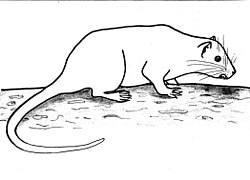Top Qs
Timeline
Chat
Perspective
List of capromyids
Species in mammal family Capromyidae From Wikipedia, the free encyclopedia
Remove ads
Capromyidae is a family of mammals in the order Rodentia and part of the Caviomorpha parvorder. Members of this family are called capromyids or hutias. They are found in the Caribbean on Cuba, Hispaniola, and nearby islands. They live primarily in forests, wetlands, and rocky areas, though some species can be found in shrublands, caves, and coastal areas. They range in size from the dwarf hutia, at 20 cm (8 in) plus a 17 cm (7 in) tail, to Desmarest's hutia, at 62 cm (24 in) plus a 31 cm (12 in) tail. Capromyids are omnivores and eat leaves, fruit, bark, and small animals. Most extant capromyids do not have population estimates, but two species—the Jamaican coney and eared hutia—are categorized as an endangered species, and four—the Bahamian hutia, Cabrera's hutia, dwarf hutia, and San Felipe hutia—are categorized as critically endangered with adult populations of 100 or less, while eight species, including the subfamilies Hexolobodontinae and Isolobodontinae, were made extinct since 1500 due to the European colonization of the Americas and introduction of non-native rats, with some species surviving until the 1900s.[1][2]

The 10 extant species of Capromyidae are divided into two subfamilies: Capromyinae, containing nine species in four genera, and Plagiodontinae, with a single species. In addition to the two extinct subfamilies, Capromyinae contains two species and Plagiodontinae three species made extinct since 1500. Capromyidae has been proposed to be merged into the family Echimyidae as the subfamily Capromyinae, with its subfamilies converted to lesser clades, but the proposal is not yet universally accepted.[3] A few extinct prehistoric capromyid species have been discovered, though due to ongoing research and discoveries, the exact number and categorization is not fixed.[4]
Remove ads
Conventions
The author citation for the species or genus is given after the scientific name; parentheses around the author citation indicate that this was not the original taxonomic placement. Conservation status codes listed follow the International Union for Conservation of Nature (IUCN) Red List of Threatened Species. Range maps are provided wherever possible; if a range map is not available, a description of the capromyid's range is provided. Ranges are based on the IUCN Red List for that species unless otherwise noted. All extinct species, subspecies, or genera listed alongside extant species went extinct after 1500 CE, and are indicated by a dagger symbol: "†".
Remove ads
Classification
Summarize
Perspective
Capromyidae is a family consisting of 10 extant species in 5 genera. These species are divided into two subfamilies: Capromyinae, containing nine species in four genera, and Plagiodontinae, with a single species. Additionally, the subfamilies Hexolobodontinae, containing a single species, and Isolobodontinae, containing 2 species in a single genus, were made extinct since 1500, as well as two species in Capromyinae and three species in Plagiodontinae.
- Family Capromyidae
- Subfamily Capromyinae
- Genus Capromys (Desmarest's hutia): one species
- Genus Geocapromys (Bahaman and Jamaican hutias): four species (two extinct)
- Genus Mesocapromys (Small Cuban hutias): five species
- Genus Mysateles (prehensile-tailed hutia): one species
- Subfamily Hexolobodontinae †
- Genus Hexolobodon † (imposter hutia): one species (one extinct)
- Subfamily Isolobodontinae †
- Genus Isolobodon † (laminar-toothed hutias): two species (two extinct)
- Subfamily Plagiodontinae
- Genus Hyperplagiodontia † (wide-toothed hutia): one species (one extinct)
- Genus Plagiodontia (Hispaniolan hutias): two species (one extinct)
- Genus Rhizoplagiodontia † (Lemke's hutia): one species (one extinct)
- Subfamily Capromyinae
Remove ads
Capromyids
Summarize
Perspective
The following classification is based on the taxonomy described by the reference work Mammal Species of the World (2005), with augmentation by generally accepted proposals made since using molecular phylogenetic analysis, as supported by both the IUCN and the American Society of Mammalogists.[6]
Subfamily Capromyinae
Subfamily Hexolobodontinae
Subfamily Isolobodontinae
Subfamily Plagiodontinae
Remove ads
References
Sources
Wikiwand - on
Seamless Wikipedia browsing. On steroids.
Remove ads






















